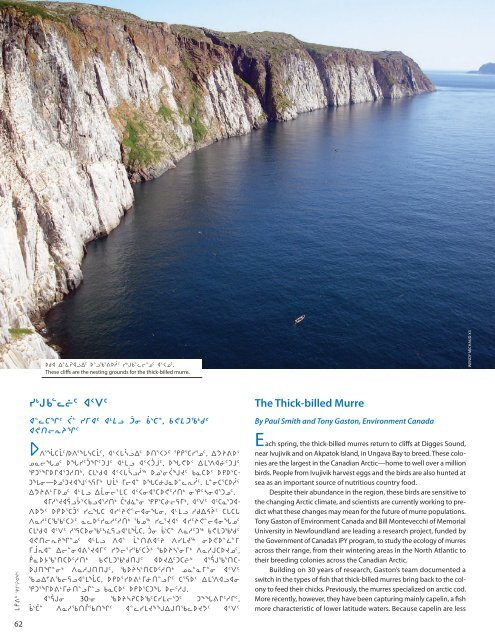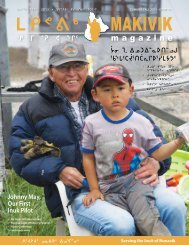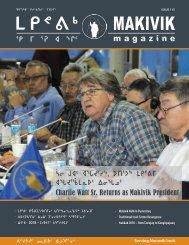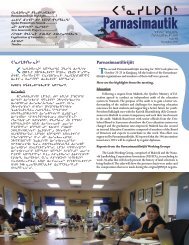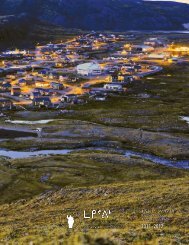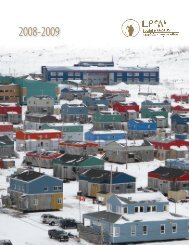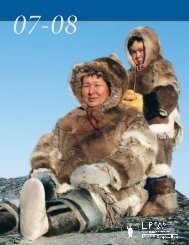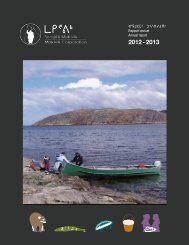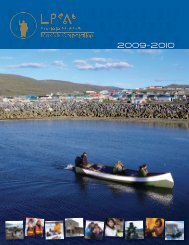Makivik Magazine Issue 90
Create successful ePaper yourself
Turn your PDF publications into a flip-book with our unique Google optimized e-Paper software.
xxxxxxxxxx<br />
Story title<br />
sfx w8ˆDxlw5 s9lc3[s§5 y4Av9Mo8k5 x2Xk5.<br />
These cliffs are the nesting grounds for the thick-billed murre.<br />
wendy michaud x3<br />
mr[4 eu3Dxq5<br />
62<br />
y4Av9Mø5 x2Ñ5<br />
x9Mbq5 Ù9 yux5 x7ml ©i Ï+b8, v?mgc4f5<br />
x?toEpq5<br />
sW3¯bµ5FsW3znbµ5, x2XZñlw5 st3XS5 er3by3k5, wKp[s2<br />
kNozk5 szy5©q5gj5 x7ml x2X©j5, sz?s2 wm3Wxî5gj5<br />
eg3qsQx3ght4. bm4fx x2XZñl§6 sk3iÙaJ5 vNbs2 srs3bgzi—sk3gJxa5nCu4<br />
Öµ4 uox8 szbîANs9ME§5. m8ib3bs§5<br />
wKp[7usk5 x7ml wµio3mb x2Xix3bs?5ht4 ie5nix3gk5.<br />
xuh3JxÇl÷3Xvlx3ht4 Ì4fˆ8i er3bîoCu4, x2Ñ5 x5bN3gx<br />
WsK5 srs3b©2 yMzb xy5p?9oxizi, x7ml hfwèº5 bZbZ<br />
WNh5bcc5bS5 NMs5yNh5ht4 ck6 yM3Jx2 xy5p?9oxizk5<br />
bm4fx x2Ñ5 h3Cbsic5n˜Clx3m¯b. ©i Ï+b8 WNh5g6 v?mgc4f5<br />
x?toEpq8k5 x7ml Wx9 µ8t[x5p WymJ6 is?s8˜8u<br />
uËEx9 wo8ix[3Jxu5 yKo3yc5bÍ4 cspn3iu4 WNhAbsJk5,<br />
®NsIc3tbs5ht4 v?mgc4ftA5 xsJw5gbø4 x3ÇAc3tbsAtq8i4<br />
WNhAttA5, cspn3tbs5ht4 kN8Nu8i x2Ñ5<br />
ckw{[coClx3m¯b, srs3ys[7uît9lQ5 b3Cs2 wm3Wxlxi<br />
eg3qs[7uît9lQ9l vNbs2 srs3bgz so5hA.<br />
x3ÇAi #)-i cspnDbsc5bymo3g5 g1z[Q5hQ5,<br />
Ï+Ì8 WNhctŒctq5 x9MymJ1awAtcMsJK5 x2Ñ5<br />
The Thick-billed Murre<br />
By Paul Smith and Tony Gaston, Environment Canada<br />
E ach spring, the thick-billed murres return to cliffs at Digges Sound,<br />
near Ivujivik and on Akpatok Island, in Ungava Bay to breed. These colonies<br />
are the largest in the Canadian Arctic—home to well over a million<br />
birds. People from Ivujivik harvest eggs and the birds are also hunted at<br />
sea as an important source of nutritious country food.<br />
Despite their abundance in the region, these birds are sensitive to<br />
the changing Arctic climate, and scientists are currently working to predict<br />
what these changes may mean for the future of murre populations.<br />
Tony Gaston of Environment Canada and Bill Montevecchi of Memorial<br />
University in Newfoundland are leading a research project, funded by<br />
the Government of Canada’s IPY program, to study the ecology of murres<br />
across their range, from their wintering areas in the North Atlantic to<br />
their breeding colonies across the Canadian Arctic.<br />
Building on 30 years of research, Gaston’s team documented a<br />
switch in the types of fish that thick-billed murres bring back to the colony<br />
to feed their chicks. Previously, the murres specialized on arctic cod.<br />
More recently, however, they have been capturing mainly capelin, a fish<br />
more characteristic of lower latitude waters. Because capelin are less


